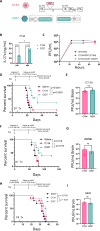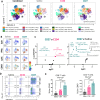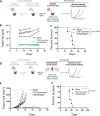Oncolytic HSV-IL27 expression improves CD8 T cell function and therapeutic activity in syngeneic glioma models
- PMID: 40623717
- PMCID: PMC12232459
- DOI: 10.1136/jitc-2025-012227
Oncolytic HSV-IL27 expression improves CD8 T cell function and therapeutic activity in syngeneic glioma models
Abstract
Background: Malignant gliomas (MGs) are the most common primary brain malignancies and are considered universally fatal. Oncolytic herpes simplex viruses (oHSVs) are promising immunotherapeutics capable of selectively lysing cancer cells, eliciting antitumor immunity, and providing local delivery of immune-activating transgenes. Interleukin 27 (IL-27) is a pleiotropic cytokine capable of enhancing tumor-reactive cytotoxic T lymphocyte (CTL) function while also possessing neuroprotective properties. We hypothesized that IL-27 expression by oHSV would enhance CTL function and improve antiglioma therapeutic activity.
Methods: We developed an oHSV that expresses IL-27 (C027). The antiglioma efficacy of C027 was tested in three syngeneic orthotopic glioma models derived from both chemical (CT-2A) and genetic (SB28, KR158) glioma lines. Spectral flow cytometry was used to assess immunophenotypic and functional changes in the tumor infiltrates and systemically. To further investigate the C027-related CTL activity, we employed in vivo cell-specific depletion and IL-27 blockade alongside in vitro T cell stimulation assays. Local and systemic antitumor memory was evaluated by both orthotopic and flank tumor rechallenge of C027-treated long-term survivors.
Results: C027 significantly prolonged survival in syngeneic orthotopic glioma models derived from both chemical (CT-2A) and genetic (KR158, SB28) glioma lines. In the CT-2A model, IL-27-expressing oHSV treatment was associated with increased intratumoral multifunctional effector CTLs and functional T cell populations systemically. Mechanistically, both CD8 T cells and IL-27 were required for the C027 survival benefit in vivo and IL-27 enhanced CTL function in vitro. C027-treated mice that survived their initial tumors had local and systemic antiglioma memory rejecting tumors on rechallenge.
Conclusions: Our findings demonstrate that IL-27 expression by oHSV significantly improves antiglioma therapeutic efficacy, enhances CTL effector function, and induces durable immune memory. Thus, IL-27-oHSV may provide a promising therapeutic approach for MGs.
Keywords: Central Nervous System Cancer; Cytokine; Immunotherapy; Oncolytic virus; T cell.
© Author(s) (or their employer(s)) 2025. Re-use permitted under CC BY-NC. No commercial re-use. See rights and permissions. Published by BMJ Group.
Conflict of interest statement
Competing interests: There are no direct competing interests. However in interest of full disclosure KAC receives licensure payments from Mustang Bio for the C134 virus, but there are no relevant financial conflicts for the technology addressed in this paper.
Figures






Update of
-
Oncolytic HSV-IL27 expression improves CD8 T cell function and therapeutic activity in syngeneic glioma models.bioRxiv [Preprint]. 2025 May 15:2025.05.12.653429. doi: 10.1101/2025.05.12.653429. bioRxiv. 2025. Update in: J Immunother Cancer. 2025 Jul 7;13(7):e012227. doi: 10.1136/jitc-2025-012227. PMID: 40463203 Free PMC article. Updated. Preprint.
References
-
- Stupp R, Hegi ME, Mason WP, et al. Effects of radiotherapy with concomitant and adjuvant temozolomide versus radiotherapy alone on survival in glioblastoma in a randomised phase III study: 5-year analysis of the EORTC-NCIC trial. Lancet Oncol. 2009;10:459–66. doi: 10.1016/S1470-2045(09)70025-7. - DOI - PubMed
MeSH terms
Substances
Grants and funding
LinkOut - more resources
Full Text Sources
Medical
Research Materials
